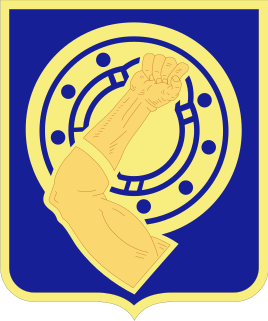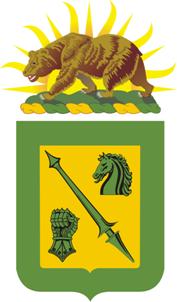
The 34th Armor Regiment is an armored regiment of the United States Army formed in 1941.

The 16th Cavalry Regiment is a Regiment of the United States Army first established in 1916. Currently the regiment includes three squadrons, all assigned to the 316th Cavalry Brigade, Fort Benning, Georgia, supporting the United States Army Armor School.
The 308th Armored Cavalry Regiment was a Minnesota-based reconnaissance unit of the United States Army Organized Reserve Corps, which briefly existed after World War II. Its 1st Battalion traced its heritage back to a World War II Tank destroyer battalion.
The 305th Armored Cavalry Regiment was an Indiana-based reconnaissance unit of the United States Army Organized Reserve Corps, which briefly existed after World War II.

The 306th Armored Cavalry Regiment was a District of Columbia-based reconnaissance unit of the United States Army Organized Reserve Corps that briefly existed after World War II. The 306th ACR later became a group before being inactivated in 1959.
The 304th Armored Cavalry Regiment was a Massachusetts-based reconnaissance unit of the United States Army Organized Reserve Corps, which briefly existed after World War II. It was constituted in 1948 and partially organized from existing units before being inactivated in 1950 and disbanded in 1952.

The 303rd Armored Cavalry Regiment was a New York-based reconnaissance unit of the United States Army Organized Reserve Corps that briefly existed after World War II.
The 302nd Armored Cavalry Regiment was a New York-based reconnaissance unit of the United States Army Organized Reserve Corps, which briefly existed after World War II. Constituted in 1948, it was partially organized later that year and inactivated in 1950.
The 301st Armored Cavalry Regiment was a Georgia-based reconnaissance unit of the United States Army Organized Reserve Corps, which briefly existed after World War II. Constituted in 1948, it was partially organized in 1949 before being disbanded in 1950.
The 300th Armored Cavalry Regiment was a Texas-based reconnaissance unit of the United States Army Organized Reserve Corps, which briefly existed after World War II. It was constituted in 1948 and partially organized from existing units before being inactivated in 1950 and disbanded in 1952.
The 309th Armored Cavalry Regiment was a Michigan-based reconnaissance unit of the United States Army Organized Reserve Corps, which briefly existed after World War II.
The 310th Armored Cavalry Regiment was a California-based reconnaissance unit of the United States Army Organized Reserve Corps, which briefly existed after World War II. It was constituted in 1948, partially organized from existing units in 1949, and inactivated in 1950.
The 311th Armored Cavalry Regiment was a Texas and Louisiana-based reconnaissance unit of the United States Army Organized Reserve Corps, which briefly existed after World War II. It was constituted in 1948, partially organized from existing units later that year, and inactivated in 1950.
The 314th Armored Cavalry Regiment was a Tennessee-based reconnaissance unit of the United States Army Organized Reserve Corps, which briefly existed after World War II. It was constituted in 1948, partially organized from existing units in 1949, and inactivated in 1950.
The 317th Armored Cavalry Regiment was an Illinois-based reconnaissance unit of the United States Army Organized Reserve Corps, which briefly existed after World War II. It was constituted in 1948, partially organized from existing units, and inactivated in 1950.
The 321st Armored Cavalry Regiment was a Virginia-based reconnaissance unit of the United States Army Organized Reserve Corps, which briefly existed after World War II. It was constituted in 1948, partially organized from existing units in 1949, and disbanded in 1952.

The 322nd Cavalry Regiment was a cavalry unit of the United States Army during the interwar period and from the Cold War to the early 1990s. The unit was activated as an Iowa and Minnesota Organized Reserve unit during the interwar period. It was converted into a tank destroyer battalion after the United States entered World War II. Reactivated in 1971 in the Army Reserve, it was eventually represented by two squadrons of the 89th Division (Training) before both were inactivated in the mid-1990s.

The 111th Armored Cavalry Regiment was a light armored cavalry regiment that was part of the California Army National Guard, briefly active during the early years of the Cold War.






